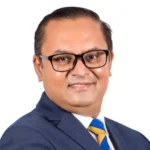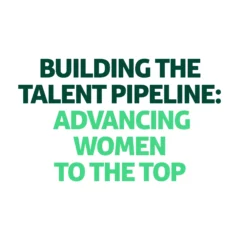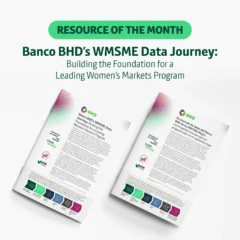
This month, the Alliance’s Karyl Akilian sat down with Syed Abdul Momen, BRAC Bank’s Head of SME Banking, for a fireside chat at the SME Finance Forum in Johannesburg, South Africa. They discussed the rise of Tara – Bangladesh’s first comprehensive banking proposition dedicated to women. Since its launch in 2017, Tara has grown to become a well-known brand, serving more than 300,000 women in Bangladesh. A summary of the conversation follows.
Karyl Akilian (KA): What are your main insights from running Tara for all these years?
Syed Abdul Momen (SM): We have learned a lot. In the past, we used to finance women entrepreneurs like we financed any entrepreneur. When we dug deep into it, we found that we were not doing enough to provide the special support that women entrepreneurs need to bring them along. That’s why we founded Tara and the special initiatives surrounding it. In Bangladesh, 50 percent of the workforce is women, 50 percent of the population is women, and if they are not included, then you are excluding 50 percent of your workforce, 50 percent of your potential customers. We know what kind of efficiency loss that is.
KA: So, what is the “secret sauce” to Tara’s success?
SM: There is no “secret sauce”. You just have to focus on the segments you want to serve. When you give a program focus, you will see how to grow it, and that’s what we have done. The kind of additional support services around women entrepreneurs that we build under the Tara umbrella are adding value––and also give us insights through which we can assess a woman entrepreneur better than before.
KA: How did you change the way you look at your portfolios to better serve women’s segments?
SM: We did two things. First, we studied our own women financing portfolio. And then we interviewed a lot of women from different segments and geographies. We also interviewed the customers of other banks and startup entrepreneurs, middle-aged entrepreneurs, seasoned entrepreneurs––all women––and we took the main points they communicated, and designed Tara based on those findings. That is why all entrepreneurs can relate to it quite well; because of that early groundwork.
KA: How did you upskill your workforce to be able to support women?
SM: That’s a very good question. We have 3,500 relationship managers across the country, and we realized that when they talk to an entrepreneur, for them, it’s just an entrepreneur. They were not considering the entrepreneur’s gender. That is an insight that we got from the underlying research––that this approach won’t work. So, we trained all 3,500 relationship managers on how to serve women entrepreneurs, emphasizing that you have to talk to them to understand their problems. You have to open the conversation.
That was the main thing we focused on––going beyond just the financials to understand their needs, showing them that you are eager to provide financial support, and making them aware of the offers available to them. For example, that they don’t need to provide their husband’s guarantee, and that we have no limits for women entrepreneurs’ time in business. You can make it an ongoing conversation; ask the entrepreneur to show you her financials, so that you can help her build a credit proposal.
So, in our week-long training we cover all these things––psychometric training, gender-lens training. And the numbers have grown phenomenally after we send the relationship managers back to the field. Earlier, the same people were saying, “We can’t find women entrepreneurs”; now they are bringing in new women entrepreneurs every day.
KA: Understanding that Bangladesh has a challenging environment when it comes to specifically targeting women, how do you navigate the challenge of putting yourself out there as focusing on women without jeopardizing the BRAC brand?
SM: I will go back to the same point: the focus. I refer to my founder, Sir Abed. When he started BRAC 50 years ago, he faced similar challenges, but at a greater extent, because at that time, people were not very educated, and the new generation was not there financially. You must focus anyway. We still say: our intention is to finance women entrepreneurs, and we will find a workaround to the social norms. But once the people that uphold those social norms see how BRAC financing took that woman from point A to point B, now she is contributing to the family expenditures––then that social norm dies away, right there. So that is how we tackle this. Not confronting, not fighting; rather, proving them wrong by doing it by example.
KA: What impact has Tara had on the BRAC brand and how has it shaped BRAC’s reputation on the market?
SM: We are the first bank in the country to look beyond the women’s financial product to a broader strategy to serve women’s segments. She can be a student; a doctor; an employee of a multinational company; an entrepreneur; she can be any individual. But when she interacts with BRAC bank, she is special. This concept was a head-turner for the industry, and then many followed. We are happy that more banks are thinking this way, because we cannot serve all these women alone.
Being the first mover in the market had a big impact. Now, everybody knows Tara as a brand. Women entrepreneurs don’t talk about BRAC bank, they talk about Tara. Tara is everywhere. Whenever I go with my friends, when paying the bill, they say “You don’t have a Tara card? You should have, because the discount is only on the Tara card.” This is what we’ve seen grow almost seven years after launching the brand.
Now we have established that brand, and we have that first mover advantage. Like Honda with two wheelers. We call the two-wheelers “Honda”. Tara has become like this for women’s banking now in Bangladesh, and we are proud of it.
KA: What are a few dos and a few don’ts when creating a women’s strategy?
SM: The biggest “don’t” is “woman-washing”. People say they want to design a product for women, but they sell the same product under a new name or design. This not only doesn’t serve the purpose, but it also hurts the brand.
If you really want to finance women, or if you really want to provide financial service to women, you must first spend time understanding them and their pain points. And then if you provide solution to address those pain points, the products will fly. So that is something I would say: do not put the cart before the horse. Understand the problems, then design the product.
KA: Finally, what’s next for Tara?
SM: For now, we are deepening our service to other women’s segments. We are designing solutions for women who are working and for women students. Going forward, we will see more segmentation, design more segment-specific products, and leverage the alternate data––the digital footprints.
Our future goal is, we will be happy when a woman entrepreneur doesn’t have to talk to me. The woman entrepreneur goes to our website, initiates a loan and gets it approved, within an hour’s time. Everything in the background will happen based on data and data only.


